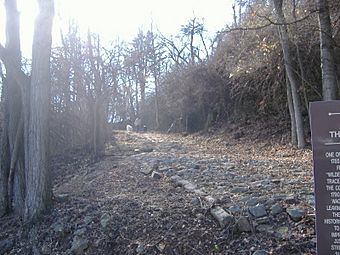Cobblestone Path facts for kids
Quick facts for kids |
|
|
Cobblestone Path
|
|
 |
|
| Location | E end of Flaget Ave., NE to Broadway, Bardstown, Kentucky |
|---|---|
| Built | 1785 |
| Architectural style | Limestone cobbled-paving |
| NRHP reference No. | 89002018 |
| Added to NRHP | November 16, 1989 |
The Cobblestone Path is a very old and important pathway in Bardstown, Kentucky. It's part of the historic area of the city. This path is made of stones and has been around since 1785. It once stretched longer, but today it runs between Flaget Avenue and Broadway. You can find it right across from the Bardstown Civil War Museum. Even though only people can walk on it now, the City of Bardstown still owns it. This is because it was always considered a main part of the city's roads.
Contents
The Historic Cobblestone Path
Building the Path
The Cobblestone Path was built in 1785. The people of Bardstown helped to build it. Back then, laws required men aged 16 to 50 to help build roads. If they couldn't work, they had to pay a small fee instead. From 1785 to 1825, this path was the main way to enter Bardstown. It was even part of the famous Wilderness Road. Because it was so important, both the Kentucky government and the United States Congress helped pay to make it better before 1800. For a short time, it was also part of the Louisville and Nashville Turnpike. Later, when new roads were built to Bloomfield, Kentucky and Springfield, Kentucky, the path became mostly for walkers and people on horseback.
Where the Path Is Now
The Cobblestone Path sits on top of a high cliff. This cliff was formed by a deep valley carved by Stewart's Creek Towne Branch. On the other side of this valley is My Old Kentucky Home State Park. The part of the path that remains is about 350 feet (110 m) long. Its width changes, from twenty-eight feet down to twelve feet. The stones used to make the path are a type of limestone called dolomite. These stones are not all the same shape. They are usually six to ten inches thick. You can also see natural limestone rocks and even a large boulder next to the path. Some of these might have been used as a place to sit. From the 1870s to 1900, the top part of the path was a popular place for picnics. People even called it Lovers Leap. Less than thirty feet below this spot is a small, dry cave. It's very hard to get into this cave.
Protecting the Path
Over the years, erosion has been a problem for the path. This means that some of the stones have been washed away, especially at the bottom. In the 1920s and 1930s, a woman named Mrs. Ernest Fulton worked hard to fight this erosion. She planted many flowers along the path. Because of her efforts and the natural plants, the path now has bush honeysuckle, evergreens, jonquils, and a spruce tree. With these plants, along with natural undergrowth, vines, and native hardwood trees, the path feels like walking through a green tunnel.
On November 16, 1989, the Cobblestone Path was added to the National Register of Historic Places. This happened because it played a very important role in the history of transportation in Kentucky.
Gallery





